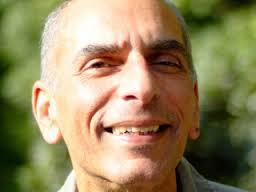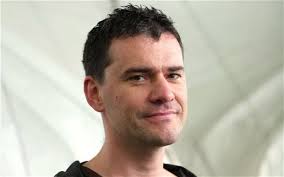Mark Cousins interviewed by Mehelli Modi
 India born Mehelli Modi’s Second Run Films famously specialises in publishing international films and forgotten classics in the UK. On the occasion of the release of Anand Patwardhan’s “War and Peace”, Mehelli interviewed Mark Cousins who a few years ago had helped curate a retrospective of Anand’s films at the Sheffield International Film Festival.
India born Mehelli Modi’s Second Run Films famously specialises in publishing international films and forgotten classics in the UK. On the occasion of the release of Anand Patwardhan’s “War and Peace”, Mehelli interviewed Mark Cousins who a few years ago had helped curate a retrospective of Anand’s films at the Sheffield International Film Festival.

Ireland born Mark Cousins is a renowned critic and filmmaker based in Edinburgh, Scotland. His films include the 2011 “The Story of Film: An Odyssey” that was broadcast as 15 one-hour television episodes and celebrated at the Toronto International Film Festival. Later, in the TV series Scene by Scene, Mark interviewed filmmakers such as David Lynch, Martin Scorsese and Roman Polanski. He is a regular contributor to Sight and Sound.
WHERE DID YOU FIRST SEE A FILM BY ANAND AND WHAT WAS YOUR REACTION TO IT?
Thanks for giving me a chance to say something about Patwardhan’s films. I wanted to see them long before I managed to do so. In the early 1990s, I read about his films, and in 1995, tried and failed to include a piece on him in Imagining Reality: The Faber Book of Documentary, the book I co-edited with Kevin Macdonald. Then, in Kim’s video store in New York, I saw Father, Son and Holy War on VHS. I bought it and watched it. My expectations were exceeded. It dwarfed most other documentaries. Though its central theme was patriarchy, it wasn’t only about that. It braided together arguments about society, gender, individualism, religious fundamentalism and superstition in a way that made it seem bigger than a movie. As I watched, I realised that Patwardhan’s films are like huge tapestries as much as films. They’re cross sections of their times, telling multiple stories of those times, then weaving those stories together into a call for change. Western cinema, both fiction and documentary, tends towards single stories with centralised themes and heroes. Indian cinema in general is less guided by unity. Masala Hindi cinema (what is called Bollywood) is often seen as compromised because it offers its audience a bit of everything – tragedy, comedy, romance, pathos, music, etc. Patwardhan radicalises masala. His mixes politics, observation, argument, shifts in time, class and nation. The result could be called a “cinema of everything”.
HOW DO ANAND’S FILMS FIT INTO THE TRADITION OF DOCUMENTARIES WHICH CHALLENGE POLITICAL NORMS, AND PROVOKE DIALOGUE?
Documentaries which try to convince people of something, or change their minds, or encourage them to action, have been very diverse. The Soviet films of the 1920s had Leninist imperatives. Leni Riefenstahl’s documentaries want to convince people that Hitler was the inevitable, and glorious, product of German history. In the UK, Edgar Anstey and Arthur Elton’s Housing Problems (1935) showed real working class people interviewed on screen, to reveal their living circumstances and, so, help improve their lives. Patricio Guzman’s The Battle for Chile films put on record an anti-democratic coup, to try to correct Chilean political history. Patwardhan’s films combine the impulses of several of these political movies. Like Housing Problems, he insists on putting on screen lives, and disadvantages, that are ordinarily ignored by cinema and TV. Robert Bresson advised us to “try to show that which, without you, might never have been seen.” This is the great impulse of realism in artists as diverse as John Cassevetes in cinema, Gustave Flaubert in literature and Theodore Gericault in painting. Anand Patwardhan is, I believe, as great as these. But his films combine the impulse to reveal truths that mainstream politics would prefer remain hidden with an essayistic, inductive approach. He says “if A and B, then C.” If nuclear weaponry has become globally associated with national power, and if India and Pakistan want to rattle their sabres, then they will divert precious funds to nuclear testing, their hubris being revealed in those tests. The first, realist, impulse nearly always results in socially valuable cinema. What social truths are best hidden? The essayist, inductive cinema depends, for its value, on the power of the induction. Riefenstahl’s films are badly argued. They draw false conclusions – about Aryans, Hitler, Germany and the Jews – from ‘evidence’ which is itself false, or poorly (to be generous) observed. Conversely, Patwardhan’s films are very well argued. Their conclusions flow from their premises. They provoke dialogue because of both realist and inductive tendencies. They show things that comfortable people don’t want to see and then, from the evidence of these things, draw conclusions (about nuclear war, masculinity, Hindu fundamentalism, Dalit people, etc) that don’t concur with those comfortable people’s sense of society. They disrupt.
AS A FILMMAKER YOURSELF, WHAT DO YOU FEEL ABOUT ANAND’S CHOICE OF SUBJECTS AND HIS FILMMAKING APPROACH TO THEM?
I wish I had a tenth of his attack or energy or overview. My films often tell stories that take place over just a few days, and are about what is visible. Patwardhan’s are epics – spanning entire social classes, political epochs and, often, continents – and are about what’s invisible: the assumptions, greed and exploitation that underlie and perpetuate disadvantage. It’s much harder to make films about invisible things like ideology than it is about cinema, cities, childhood, or walking, which are some of my themes. You have to dig beneath the surface. Patwardhan is a great digger. He has unearthed worlds, worlds of power, ego and privilege.
HAS WATCHING ANAND’S FILMS CHANGED, CHALLENGED OR ENRICHED YOU IN ANY WAY THAT YOU CAN DESCRIBE?
Yes. If it wasn’t for him, I wouldn’t understand India. If it wasn’t for his films, I wouldn’t really get how the BJP, for example, distorts the country’s past and unlevels its playing field in the present. Watching his films, you have eureka moments – times when you finally get to see, clearly, how nation, religion, gender and power fit together and conspire to exclude. And then there’s his filmmaking itself. Seeing Jai Bhim Comrade, for example, was a joy because it showed me how the traditions of musical interlude in Indian cinema could be redeployed for radical intent. There’s the pleasure of the long form story, of strands coming together, of an overview emerging.
ANAND HAS BEEN MAKING HIS FILMS SINCE THE 1970S. WHY DO YOU THINK HIS WORK IS STILL RELATIVELY UNKNOWN/UNSEEN IN THE WEST?
To be honest, I think we in the West undervalue Patwardhan’s films because we are more interested in white filmmakers. We have post-colonial assumptions like “India is chaos” and, so, don’t expect one of the world’s most cogent directors to come from that country. As film was invented in the West, we somehow assume that we will be the best at it and that India will always be learning from us. In terms of the films’ content, most westerners have limited ways of conceptualising India: through the lens of the Beatles’ encounter with Indian spiritualism; Gandhi’s passivism; Mother Teresa; Princess Diana’s photo at the Taj Mahal; the ‘sensory overload’ of the place when you visit it on holiday; the kitsch of Hindi cinema, etc. Not enough people are really interested in what the BJP is, of what Shiv Sena is. The BJP is as significant for world politics as, say, the Republican party in the US, about which we hear far more. For the west, India is other. It wants an impressionistic and sensory experience of it rather than a structural understanding of it. Then there’s the alleged digressory nature of Patwardhan’s films. Whereas, as mentioned earlier, western art tends to Aristotelian unities, Patwardhan’s films frequently park point A in order to introduce point B, which he will develop for perhaps twenty minutes or more, before returning to point A and showing how each is related to the other. This requires patience in the viewer. And we need to mention the degree of incuriosity about Indian documentary in western film programmers, writers, curators, magazine editors and historians. More than once when I’ve mentioned Indian non- fiction cinema, the response has been “is there any?”
MANY OF ANAND’S FILMS – AND PARTICULARLY WAR AND PEACE – HAVE FACED LONG CENSORSHIP BATTLES IN INDIA. WHY IS HIS WORK CONSIDERED DANGEROUS?
India has had long periods of authoritarian politics, during which times culture is controlled. Patwardhan’s films challenge fundamental aspects of Indian life – the state-religion-gender-caste matrix, for example – and the elites and their vested interests are unsettled. The establishment then protects itself by attacking Patwardhan’s films and, usually, trying to silence him and them. They don’t want what he says to be said, because what he says is persuasive, and it’s persuasive because it’s true. If enough people saw those truths, and voted accordingly, the citadel would collapse. WAR AND PEACE WAS MADE IN 2002. IS IT STILL RELEVANT? Very. For lots of reasons. The BJP is back in government. Nuclear power and weaponry are still, today, expressions of nationalism and aggression. Militarism is as old as states. The life and death implications of atomic science are still being revealed. Authoritarianism is on the rise. The depletion of fossil fuels and the increase in global energy consumption mean that nuclear energy is under the spotlight again. India’s global power is in ascendance. Patwardhan’s masterpiece is as relevant as ever. Thanks for asking these questions. I feel that my answers haven’t done justice to Patwardhan’s great work. Sorry.